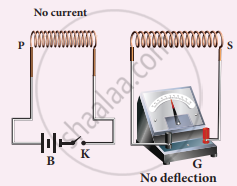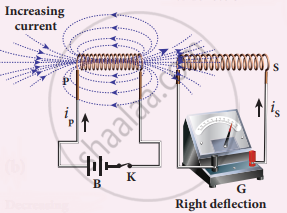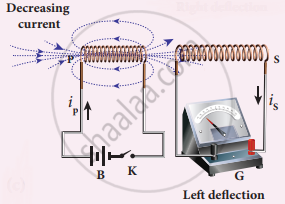Advertisements
Advertisements
प्रश्न
Establish the fact that the relative motion between the coil and the magnet induces an emf in the coil of a closed circuit.
उत्तर
- In first experiment when bar magnet is placed close to the coil, magnetic lines pass through coil, the magnetic flux in coil increases and emf is induced hence electric current flows in the circuit.
- At the same time when they recede away from one another magnetic flux decreases emf is induced in opposite direction. Current flows in opposite direction. So there is a deflection in the galvanometer.
- In the second experiment, when the primary circuit is open, no electric current flows in it, magnetic flux linked with the secondary coil is zero.

(a) Right deflection - When primary circuit is closed, increasing current produces a magnetic field. So magnetic flux linked with coil increases. This induced current in the secondary coil.

(a) Left deflection - When the primary circuit is broken, decreasing primary current induces a current in the secondary coil but in opposite direction. So there is a deflection in Galvanorneter.
(a)
(b)
(c)
APPEARS IN
संबंधित प्रश्न
A horizontal straight wire 10 m long extending from east to west is falling with a speed of 5.0 m s−1, at right angles to the horizontal component of the earth’s magnetic field, 0.30 × 10−4 Wb m−2.
- What is the instantaneous value of the emf induced in the wire?
- What is the direction of the emf?
- Which end of the wire is at the higher electrical potential?
Name a common device that uses electromagnets.
The north-south polarities of an electromagnet can be found easily by using:
(a) Fleming's right-hand rule
(b) Fleming's left-hand rule
(c) Clock face rule
(d) Left-hand thumb rule
State the purpose of soft iron core used in making an electromagnet.
What is an electromagnet? What do you know about the simplest form of an electromagnet?
The energy stored in a 50 mH inductor carrying a current of 4 A is ______
The right-hand thumb rule is also called _______ rule.
An alternating emf of 0.2 V is applied across an L-C-R series circuit having R = 4Q, C = 80µF, and L = 200 mH. At resonance the voltage drop across the inductor is
Which of the following instruments works by electromagnetic induction?
When an electric current is passed through a wire or a coil, a magnetic field is produced. Is the reverse phenomenon possible i.e, can a magnetic field produce an electric current? Explain with the help of an appropriate example.
